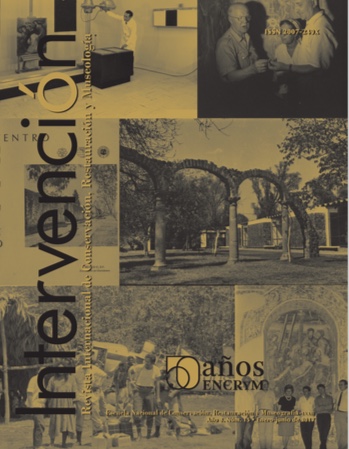Estudio comparativo de sistemas de consolidación y flexibilización (almidón-PEG, quitina-PEG y lactitol-PEG) para la conservación de objetos de fibras duras provenientes de contextos arqueológicos secos y húmedos en México
Published 2025-01-16
Keywords
- consolidation,
- hard-fibers,
- archeology,
- lactitol,
- chitin
- starch,
- flexibilizer,
- polyethylene glicol ...More
Copyright (c) 2017 Instituto Nacional de Antropología e Historia (INAH)

This work is licensed under a Creative Commons Attribution-NonCommercial 4.0 International License.
How to Cite
Abstract
This research focused on developing and assessing a viable method for the conservation of archeological artefacts made of hard-fibers (palm), which were found in both with dry (Cueva del Lazo, Chiapas, Mexico) and wet (ritual deposits of the Archeological Site of the Templo Mayor de Tenochtitlan, Mexico City, Mexico) contexts; that is, the most favorable environmental conditions for the preservation of cellulosic materials. Its purpose was to test three different consolidation products: starch, lactitol, and chitin in a mixture with a flexibilizer (polyethylene glycol or peg) at different concentrations. The studie evaluated the results post-treatment in relation to the macroscopic physical characteristics in the treated objects, particularly: the physical resistance gain, the improvement in the fibers´ cohesion and the enhancement of their flexibility. Scanning electron microscopy (sem) served to visualize the extent of consolidation in the cellular structures and, thus, to corroborate the macroscopic characteristics achieved with the applied consolidation systems. As a result, this investigation determined the most adequate variants for the estabilization treatment of hard-fiber archeological elements.
Downloads
References
- AIC-Wiki (2016). “Adhesives for Paper”, Paper Conservation Catalog, American Institute for Conservation-Wiki [página web], documento electrónico disponible en http://www.conservation-wiki.com/wiki/Adhesives_for_Paper, consultado en noviembre de 2016.
- Alonso Olvera, Alejandra, Teresa Reyes Tzompatzi y Demetrio Mendoza Anaya (2001). “Conservación de maderas arqueológicas húmedas: perspectiva actual y retos para el futuro en México”, Conserva, 5:57-79.
- Allington, C. (1986). “The Consolidation of Cellulosic Fibre Materials”, abstracts of papers presented at Symposium 86: The Care of Ethnological Materials, Ottawa, Canadian Conservation Institute, 55-56.
- Argüelles, Amaranta y Osiris Quezada (2009). “Proyecto Templo Mayor, Séptima Temporada, Informe de la Operación 2”, mecanoescrito, México, MTM-INAH.
- Carrlee, Ellen and Senge, Dana (2016). “Treatment Results for Waterlogged Archaeological Basketry at the Alaska State Museum”, proceedings of the 12th ICOM-CC Group on Wet Organic Archaeological Materials Conference. May 13 to 17, 2013 Istanbul, Turkey. Editors Tara Grant and Clifford Cook. Pp. 263-269. Published by the International Council of Museums (ICOM), Committee for Conservation, Working Group on Wet Organic Archaeological Materials. Printed in Canada by Lulu.com
- Chávez, Ximena (2009). “Proyecto Templo Mayor Séptima Temporada Informe de la Operación 1”, mecanoescrito, México, MTM-INAH.
- Conde, Mónica (2007). “Las promesas de la quitina. El segundo polímero natural más abundante”, Ambiente Plástico, documento electrónico disponible en http://www.ambienteplastico.com/artman/publish/article_769.php, consultado en noviembre de 2016.
- Cruz Flores, Sandra (2004). “Dictamen y propuesta de conservación de los materiales arqueológicos procedentes de la Cueva del Lazo”, mecanoescrito, México, CNCPC-INAH.
- Díaz Rodríguez, Jorge Abraham (2006). “Los suelos lacustres de la Ciudad de México”, Revista Internacional de Desastres Naturales, Accidentes e Infraestructura Civil, 6 (2):111-130.
- Escalante-Lozada, Adelfo, Guillermo Gosset-Lagarda, Alfredo Martínez-Jiménez y Francisco Bolívar-Zapata (2004). “Diversidad bacteriana del suelo: métodos de estudio no dependientes del cultivo microbiano e implicaciones biotecnológicas”, 38:583-592.
- Florian, Mary-Lou E., Dale Paul Kronkright y Ruth E. Norton (1990). The Conservation of Artifacts Made from Plant Materials, Marina del Rey/EUA, The Getty Conservation Institute.
- Imazu, Setzuo y Andràs Morgòs (1997). “Conservation of Waterlogged Wood Using Sugar Alcohol and Comparison the Effectiveness of a lactitol, sucrose, and PEG 4000 treatment”, en Per Hoffmann, James A. Spriggs, Kristiane Strætkvern y David Gregory (eds.), Proceedings of the 6th ICOM Group on Wet Organic Archaeological Materials Conference, York, 1996, Bremerhaven 1997:235-254.(1999). “Lactitol Conservation in an Open Air Environment of Large Wood Elements of a 5th Century, A. D. Dogout Pipeline”, en Janet Bridgland (ed.), ICOM Committee for Conservation 12th Triennial Meeting Lyon, 29 August-3 September, Londres, James & James, II:614-618.
- Linares Villanueva, Eliseo (1998). “Cuevas arqueológicas del río La Venta, Chiapas”, tesis de maestría en arqueología, México, ENAH.
- Miranda-Ham, Susana y Gloria Martha Sánchez Valenzuela (1996). “Conservación de textiles y cordelería prehispánica, cuevas: ‘El Gallo’ y ‘La Chagüera’, Ticumán, Morelos”, tesis de licenciatura en restauración, México, ENCRyM-INAH.
- Page, Susan (1997). “Conservation of Nineteenth-century Tracing Paper: a Quick Practical Approach”, The Book and Paper Group Annual, vol. 16, The American Institute of Conservation, documento electrónico disponible en http://cool.conservation-us.org/coolaic/sg/bpg/annual/v16/bp16-09.html, consultado en noviembre de 2016.
- Pantone LLC (2016). “About Pantone” [página web], X-Rite, Incorporated, ©Pantone LLC, Carlstand, Nueva Jersey, documento electrónico disponible en http://www.pantone.com/about-us?from=topNav, consultado en octubre de 2016.
- Rampton, Amelia (2005). Almidón de la casaba y almidón de trigo: estudio comparativo para su uso en la conservación de papel, The Getty Conservation Institute, documento electrónico disponible en http://ge-iic.com/files/2congresoGE/Almidon_de_la_casaba_y_de_trigo.pdf, consultado en octubre de 2016.
- Schiraldi, Chiara, Isabella di Lernia y Mario de Rosa (2002). “Trehalose Production: Exploiting Novel Approaches”, Trends en Bytechnology, 20 (10):420-425.
- Sease, Catherine (1994). A Conservation Manual for the Field Archaeologist, Cotsen Institute of Archaeology, documento electrónico disponible en https://escholarship.org/uc/item/8ft6488x, consultado en octubre de 2016.
- Smith, Margaret J., Thomas Hugh Flowers y Frances J.Lennard (2015). “Mechanical Properties of Wool and Cotton Yarns Used in Twenty-first century Tapestry: Preparing for the Future by Understanding the Present”, Studies in Conservation, vol. 60 (6):1-9, Current Research in Conservation Science Issue.
- Vanden, Berghe (2012). “Towards an Early Warning System of Oxidative Degradation of Protein Fibres in Historical Taperstries by Means of Calibrated amino acid Analysis”, Journal of Archaeological Science, 39 (5):1349-59.
- Unger, Achim; Schniewind, Arno P y Unger, Wibke (2001). Conservation of Wood Artifacts. A Handbook, Natural science in archaeology, Berlin/Nueva York, Springer.

